Scan Magazine: 2004-12-14
Now and Then: 25 Years of Electronic Art.
Timeshift At Ars Electronica

ARS Electronica Festival Programme

Ars Electronica in 2004 was more than a survey of recent art and theory in the digital domain. This year?s event was framed by the 25 year history of Ars Electronica itself. This anniversary provided the opportunity to reflect not only on the changes over 25 years of this annual event held in Linz, Austria, but on the broader developments within electronic arts, cultural movements and social networks across a turbulent quarter-century.
The designated theme “Timeshift” proposed to look forward another 25 years, speculating on the “driving forces in art, technology and society over the next quarter century.” The rival spirits of techno-optimism and apocalyptic despair were projected across a range of symposiums on the themes “Progress”, “Disruption”, “Spirit” and “Topia”.
But the more interesting ? and less speculative ? imperative was retrospective: a consideration of the pathways taken by electronic art and culture since 1979. Looking twenty-five years into the future entails guess-work, the imposition of vested interests, hope and fear. Looking backwards twenty-five years entails the joys of hindsight, the wonder at pioneers and visionaries, and the wry superiority of the present (from the perspective of 2004,1979 equates to technological primitivism). More fruitfully, the retrospective vision invites reflection and revision, especially when stimulated by the archival resources displayed at Linz in 2004.
Ars Electronica is an ambitious event, incorporating conferences, lectures and symposiums as well as a festival of electronic arts based on the prestigious Prix Ars Electronica. This competition in 2004 attracted over 3,000 entries channelled into 5 categories: Interactive Art, Net Vision, Digital Musics, Computer Animation/Visual Effects, and Digital Communities. Prix forums were held with the winners of each category, allowing ideas and arguments to be voiced directly by and to the “Golden Nica” winners. Apart from all this activity, Ars Electronica 2004 offered music concerts, multimedia performance events, an “electrolobby” fringe, an exhibition of previous award-winning interactive works going back to 1990, a “timeline” archival presentation of Ars Electronica?s 25 years, as well as related events and exhibitions.
The sheer volume of media art on display, from both past and present, encouraged a critical perspective. How does contemporary work compare to that of the “distant” past ? all the way back to 1979? Are there aesthetic criteria relevant to all this art, or do the earlier works need to be situated in their original context, and judged accordingly? Is there a discernible “progress” in the ambition and scope of electronic art, parallelling technological innovation? Or, more sharply, is electronic media art tied to the properties and developments of digital technology, to its detriment?
The first exhibit worth considering in pursuit of answers to these questions was the “Digital Avant-Garde”, a selection of prize-winning works mainly from the early 1990s. Interactive works by such influential artists as Luc Courchesne, Paul Sermon, Lynn Hershman and Jeffrey Shaw were restaged and installed in their original form. In one respect it was heartening to see a cyber-art event honouring earlier, pioneering works. The cult of the new is so dominant in contemporary post-industrial societies that most cultural forms more than a few years old are dispatched to oblivion with cold contempt. An art practice built on processing power and technological breakthroughs runs the risk of fostering a perpetual “five minutes into the future” vision, with backs sullenly turned on tradition. So the respectful exhibition of works over ten years old, as well as the other “timeline” representations of previous art and theory, was a welcome antidote to the contemporary “withering of the past”.
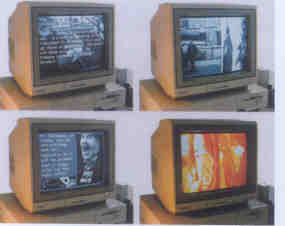
Think About the People Now , Paul Sermon (UK) 1991
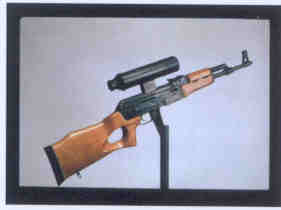
America?s Finest , Lynn Hershman (USA) 1989-1993
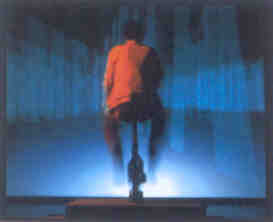
The Legible City , Jeffrey Shaw (Aus) 1988-1991
On the other hand, the presentation of these works focused attention on new media art?s dependence on new technology. Given the inexorable march of the technology, art works based on previous generations of computers and machines may be perceived as outmoded by association. Generations of technology hurtle by at rates far faster than biological generations, and barely anyone remembers ? or wants to remember ? computers from four generations ago. They are simply old and superseded. So it is very hard to resist the impulse to regard these old new media works as somehow “dated”. They may have forged new praxes of ideas and technology in their day, but in this day ? when sophistication of praxis and technique is expected ? they will seem to many observers “quaint” and old-fashioned.
This may be an inevitable consequence of the nature of media art, and the nature of the passing of time. A more troubling issue, however, concerns the classification of pioneering digital artworks as “avant-garde”. These works are not avant-garde in the manner of Duchamp or Man Ray. They don?t provoke or shock; they don?t challenge society to follow in their wake. These early computer-based interactive works are only “avant-garde” in the sense that they went before: a strangely nostalgic notion of artistic antecedent. Or perhaps “avant-garde” is simply re-defined, in electronic art practice, to mean “cutting-edge” technical innovation: a devaluation of the term.
The Prix Ars Electronica 2004 exhibition of interactive works stimulated further critical reflection on the status of computer-based art. Ars Electronica is a showcase, every year, of innovative “cyber-art”; the presence of so many contemporary works, from a broad range of international artists, would satisfy the most demanding “interactive junky”. Darren Tofts, who describes himself in those terms in his review of the 2004 Sydney Biennale, (“The Odour of a Rose: Media Arts at the Sydney Biennale”, Scan) has lamented the under-representation of interactive works at the Sydney event. Yet the bifurcation - between exhibitions devoted to digital art and those international shows, like Sydney Biennale, privileging more traditional forms such as painting and sculpture -points to questions concerning the current status of computer-based works.
There is no doubt that the state of computer-interactive art as a specific form is healthy: internationally, artists and researchers are well-funded to produce large-scale and expensive works. Yet for much of the global art world, “new media” art (excluding venerable video art) is viewed with some suspicion. Many interactive works are dismissed as gimmicky, as the parading of new technology for its own sake, as mere exercises in technique, or as the application of a research idea with little subtlety or aesthetic merit. The return, in some international art shows, to a predominance of old-fashioned forms such as painting, suggests to some critics a turn away from digital technology, or perhaps that the interactive moment has passed.
A mildly sceptical visitor to the 2004 Prix Ars Electronica exhibition, in the interactive category, would have found much to enhance that scepticism. Several works were conceptually sophisticated, even ingenious; most were well designed and presented. Yet very few of the many works on display achieved that melding of idea, creativity and execution expected of a significant work of art. Some of the ideas underpinning the works were startling or witty: a computer in the form of a train; television programming rendered as abstract pattern; Siamese fighting fish interacting with robotic sculptures in a fish-bowl. Yet each of these works, and many others, needed supplementary information ? an explanatory sheet, or explanation provided by the ever-helpful young volunteer staff ? for the conceptual underpinning to become apparent. Without this extra information, these works (winners of Honorary Mentions and Awards of Distinction in the Interactiive category) would appear to most viewers as, respectively: a small train, a TV accompanied by patterns, and fish and little sculptures in a bowl.
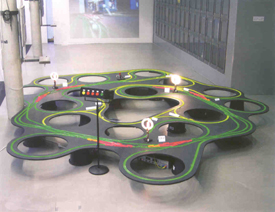
Turing Train Terminal , Severin Hoffman, David Moises (Austria)
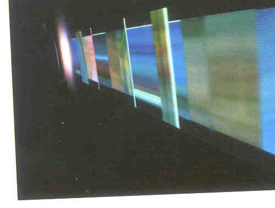
We Interrupt Your Regularly Scheduled Program , Daniel Sauter, Osman Khan (USA)

Augmented Fish Reality , Ken Rinaldo (USA/France)
Perhaps this is to be unduly harsh on interactive conceptual art. Perhaps these kinds of works require, by their very nature, supplementary explanations. If that is so, computer-based art, exploring the fusion of concept and technological innovation, should be judged according to specific criteria ? including allowance for explanatory text. Yet it?s also apparent that the best interactive works - those that leave lasting impressions, those that are valued beyond the specific confines of computer-based art festivals ? do not necessarily require such supporting statements.
This is certainly the case with the Nica Prize winning entrant in the Interactive category at Prix Ars Electronica 2004: Listening Post, by Mark Hansen and Ben Rubin (USA). Entering a large dark room, the audio-viewer experiences a vast board comprised of 231 rapidly changing electronic displays. The closest analogue is a flight information board at a major airport. Listening Post incorporates electronic speech and music into this display, creating an entrancing audio-visual environment. The mood created by the work is poetic and slightly melancholy, as in the recent video installations by Ugo Rondinone. The raw material of Listening Post is the internet: realtime text communications in thousands of online forums. This huge volume of messaging is sorted according to themes such as “I like” and “I love”; at times the messages are nonsensical as they flicker on and off the display. The overall effect is hypnotic: we witness a huge poetic machine, sifting the “collective intelligence” of the Net through a constantly shifting pattern. There is both abstraction ? flickering text as movement and shape ? and meaning, drawn from the online forums? original material. There is the thrill of witnessing a representation of very recent online communication (the sound artist Scanner has previously entered this territory, probing the illicit thrill associated with intercepted mobile phone conversations as raw material for electronic art). Listening Post adds the visual representation, the pattern and movement, evoking a sense of the sheer magnitude and flux of internet communication.
Click to watch video
A couple of observations pertinent to the broader topic of interactive art may be made here. First, Listening Post succeeds as a major work of art because it evinces those qualities missing in many of the other interactive works on display at Ars Electronica: ambiguity and ? dare we say it ? humanity. The work generates a strange mix of emotions in the audio-viewer: awe, fascination, pathos. Beneath the algebraic patterning of text and light lies the emotional content of the messages. The female electronic voice further humanises the traffic of data and text. It is ultimately the combination ? even confusion ? of emotional responses that draws and maintains the viewer?s attention.
The second point to be made is that Listening Post is not really an interactive work. At least, it is not interactive in the previously accepted meaning of the term: an art work offering users a number of choices or options as they engage with the work. As was remarked at the Prix Forum discussion, Listening Post is more a cinematic work than an interactive one. The audio-viewer sits, watches and listens; is entertained, awed, enchanted. There is no other facet to the viewer?s experience of the work. The judges of the Prix Interactive Art acknowledged this in their commentary, noting that the term “interactive” needs to be re-defined to accommodate Listening Post. The interactivity is not between viewer and work, but between the computer coding and the masses of raw internet material it encounters.
This manoeuvre may seem, to a cynical observer, little more than an administrative sleight-of-hand, ensuring that a major work wins a major prize. Yet ? less cynically ? it may be seen as acknowledgement of the sophistication of coding needed to power such a work as Listening Post. The artist/designers of this work have created code capacious and flexible enough to absorb gigantic volumes of information, rendering them into the stuff of art. In effect, the computer code is “empowered” to interact with realtime information, generating as a result a perpetually contemporary work of art.
As suggested above, these fine points of definition would mean nothing if the resultant art works lacked quality. Listening Post is a haunting piece that transcends the limitations of many other computer-based works. But it was a long way ahead of the other works on display at Linz.
Ah_Q , an installation by the Chinese artist Feng Mengbo, may have been removed from the subtlety and mood of Listening Post, yet it too succeeds due to the complexity of its message.
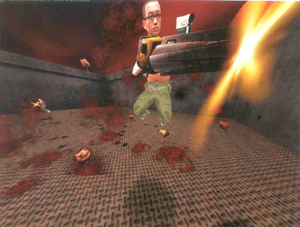
Ah_Q , Feng Mengbo (China)
An intervention into Quake III, this work invites the participant to “play” the violent action scenario ? but this version is peopled by multiple versions of the artist. Swirling around inside this work are reflections on the lure of violence, the aestheticisation of the military, the role of the artist in an authoritarian/consumer society ? and much else.
These two works, in their wildly different ways, offered something more than technological gimmick, elaboration of research idea, or mere novelty. If other prix entrants on display lacked their distinction, these works ? especially Listening Post ? set a high standard. Otherwise, the impetus at Ars Electronica 2004 seemed to lie not with individual art works, but with the possibilities opened by digital networking and communities. This rapidly expanding field, as recognised by the Ars Electronica categories Net Vision and Digital Communities, is currently attracting massive theoretical and critical interest.
John Potts is Associate Professor in Media at Macquarie University, Sydney
